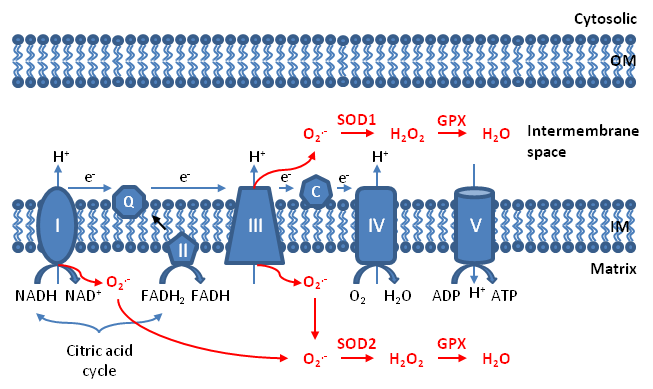
How does mitochondria generate ATP?
Answer
477.9k+ views
Hint: Mitochondria are double membrane-bound cell organelles that generate most of the cell's energy needed for biochemical reactions. Chemical energy produced by the mitochondria is stored in the form of a small molecule called adenosine triphosphate (ATP). Mitochondria have their own DNA which is inherited from their mother.
Complete answer:
As previously mentioned, mitochondria contain two major membranes. The outer mitochondrial membrane fully surrounds the inner membrane, with a little intermembrane space in between. The outer membrane has many protein-based pores that are large enough to permit the passage of ions and molecules as large as a little protein. In contrast, the inner membrane has far more restricted permeability, very similar to the cell wall of a cell. The inner membrane is additionally loaded with proteins involved in electron transport and ATP synthesis.
This membrane surrounds the mitochondrial matrix, where the acid cycle produces the electrons that travel from one protein complex to subsequent within the inner membrane. At the top of this electron transport chain, the ultimate electron acceptor is oxygen, and this ultimately forms water ($H_20$). At an equivalent time, the electron transport chain produces ATP.
During electron transport, the participating protein complexes push protons from the matrix into the intermembrane space. This creates a degree gradient of protons, then another protein complex, called ATP synthase, is used to power synthesis of the energy carrier molecule ATP.
ATP synthase forms ATP from adenosine diphosphate (ADP) and an inorganic phosphate (Pi) through oxidative phosphorylation, which is a process in which enzymes oxidize nutrients to form ATP.

Note:
Mitochondria multiply when the energy needs of a cell increase. Therefore, power-hungry cells have more mitochondria than cells with lower energy needs. For example, repeatedly stimulating a muscle cell will spur the production of more mitochondria in that cell, to keep up with energy demand.Mitochondria, the so-called "powerhouses" of cells, are unusual organelles therein they're surrounded by a double membrane and retain their own small genome. They also divide independently of the cell cycle by simple fission.
Complete answer:
As previously mentioned, mitochondria contain two major membranes. The outer mitochondrial membrane fully surrounds the inner membrane, with a little intermembrane space in between. The outer membrane has many protein-based pores that are large enough to permit the passage of ions and molecules as large as a little protein. In contrast, the inner membrane has far more restricted permeability, very similar to the cell wall of a cell. The inner membrane is additionally loaded with proteins involved in electron transport and ATP synthesis.
This membrane surrounds the mitochondrial matrix, where the acid cycle produces the electrons that travel from one protein complex to subsequent within the inner membrane. At the top of this electron transport chain, the ultimate electron acceptor is oxygen, and this ultimately forms water ($H_20$). At an equivalent time, the electron transport chain produces ATP.
During electron transport, the participating protein complexes push protons from the matrix into the intermembrane space. This creates a degree gradient of protons, then another protein complex, called ATP synthase, is used to power synthesis of the energy carrier molecule ATP.
ATP synthase forms ATP from adenosine diphosphate (ADP) and an inorganic phosphate (Pi) through oxidative phosphorylation, which is a process in which enzymes oxidize nutrients to form ATP.

Note:
Mitochondria multiply when the energy needs of a cell increase. Therefore, power-hungry cells have more mitochondria than cells with lower energy needs. For example, repeatedly stimulating a muscle cell will spur the production of more mitochondria in that cell, to keep up with energy demand.Mitochondria, the so-called "powerhouses" of cells, are unusual organelles therein they're surrounded by a double membrane and retain their own small genome. They also divide independently of the cell cycle by simple fission.
Recently Updated Pages
Why are manures considered better than fertilizers class 11 biology CBSE

Find the coordinates of the midpoint of the line segment class 11 maths CBSE

Distinguish between static friction limiting friction class 11 physics CBSE

The Chairman of the constituent Assembly was A Jawaharlal class 11 social science CBSE

The first National Commission on Labour NCL submitted class 11 social science CBSE

Number of all subshell of n + l 7 is A 4 B 5 C 6 D class 11 chemistry CBSE

Trending doubts
Differentiate between an exothermic and an endothermic class 11 chemistry CBSE

10 examples of friction in our daily life

One Metric ton is equal to kg A 10000 B 1000 C 100 class 11 physics CBSE

Difference Between Prokaryotic Cells and Eukaryotic Cells

1 Quintal is equal to a 110 kg b 10 kg c 100kg d 1000 class 11 physics CBSE

State the laws of reflection of light




